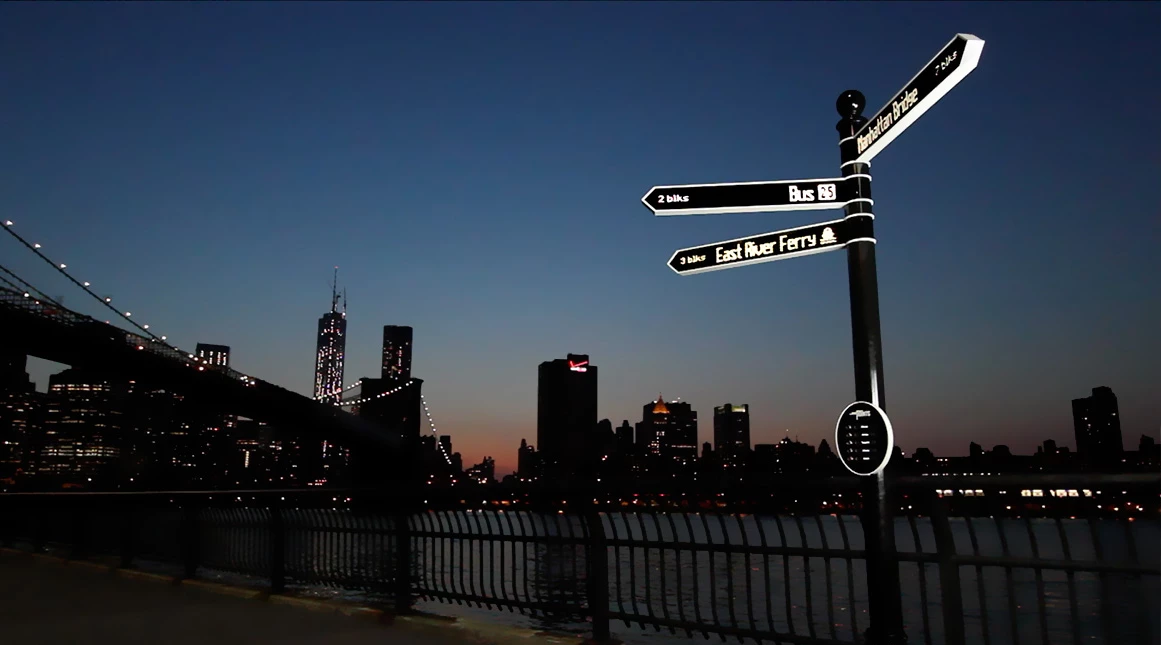In our increasingly connected world, isn't it about time the humble street sign received a high-tech upgrade? That's certainly the thinking behind Points, the newest project from Breakfast, a New York-based design group. Points is an internet-connected directional sign that pulls data from social media and spins its arms up to 360 degrees to aim in the direction of a location or event.
At a glance, Points looks like any other directional sign, with three arrows pointing toward designated spots. Once a person makes a selection on the menu near its base though, the signs rotate toward the three nearest places that match the chosen criteria. At the same time, the LED displays on each one will change to show the name of the location along with pertinent information.
For example, if someone selects "Transit," the sign might point out the nearest subway stations or bus stops, along with an estimated walking distance and the next departure time for each one.
Points connects to the internet via Wi-Fi or Ethernet to pull current information from a wide range of sources, including Twitter, Foursquare, RSS feeds, and transportation APIs. Using this data, the system can determine if any special events are happening nearby, find the most popular landmarks for tourists, or pick out the highest rated restaurants and stores in the area.

No matter where it's installed, Points adapts to its location to provide relevant directions and can be programmed to draw from other data sources if needed. The user menu can also change its selections appropriately throughout the day. In the morning, it might show options for "Breakfast" and "Coffee," for example, but will display "Dinner" and "Drinks" in the evening. Points can even act as a rotating news ticker, showing current events and sports scores while turning toward the site of each game or news story.
Breakfast spent over three years developing the concept into a reliable model that could blend in as a street sign while providing the most accurate directions possible. The final product measures 9 ft (2.7 m) tall, with 3 ft (0.9 m) arms at the top. According to the developers, about 90 percent of Points is built from aluminium, making it durable enough for different environments but still lightweight for transportation.
The design team built a custom system of gears and motors that could fit inside a slim pole and provide smooth motion to each arm. The sign uses rotary electrical interfaces to move the arms 360 degrees in either direction without tangling any wires, while a 200 pulse per rotation quadrature encoder monitors its exact degree of rotation. Each sign contains an array of 16,000 LEDs to display locations and info, which is controlled by energy-efficient XMega processors.

It's pretty easy to picture some specific locations where a Points sign would come in handy. For example, aside from tourist hot spots, the system could be programmed for specific events, showing which bands are on stage at a music festival or where to find the next keynote at a conference.
The designers at Breakfast are currently accepting orders to place Points at special events, provided the organizers can meet certain space and internet requirements. They're also looking into making completely weather-proof models that could be installed permanently.
For now though, anyone can visit the Points official website and send a tweet to a prototype to watch it spin toward their location in real-time. You can also check out the video below to see the rotating electronic street sign in action.
Source: Breakfast








